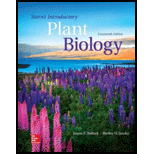
Concept explainers
To write:
Definition of calyx, corolla, peduncle, receptacle, pedicel, pistil, filament, ovary, and carpel.
Introduction:
A flower at certain times also known as blossom or bloom refers to the reproductive composition found in the flowering plants, also known as
Explanation of Solution
Calyx refers to the outermost whorl of the flower. It comprises three to five small green colored leaf-like compositions known as sepals. The sepals of a flower in combination are known as calyx. It protects the flower when the flower is present in its bud phase.
The next whorl of the flower that comprises three too many petals is in a combination known as corolla. They work primarily to fascinate pollinators. They are the conspicuous section in various trees. Every flower starts as an embryonic priprimodium. It forms into a bud over the specialized branch at the tip of a stalk known as a peduncle.
In certain cases, when the peduncle exhibits branchlets of small stalks it is known as pedicels. Receptacle refers to the expanded tip of the flower axis or stalk, which contains the floral organs. Stamens are connected with the receptacle around the base of the greenish pistil at the center of the flower. Each stamen comprises slender and semi-rigid filament with a sac.
The upper part of the stigma is associated via a slender stalk-like style to the swollen base known as ovary. The ovaries comprise ovules within them, and such ovules bearing parts are known as carpels.
The calyx, corolla, receptacle, peduncle, pedicel, pistil, filament, ovary, and carpel are the essential parts of a flower. Each of these structure plays an essential role in the process of reproduction.
Want to see more full solutions like this?
Chapter 8 Solutions
Stern's Introductory Plant Biology
- 22. Which of the following mutant proteins is expected to have a dominant negative effect when over- expressed in normal cells? a. mutant PI3-kinase that lacks the SH2 domain but retains the kinase function b. mutant Grb2 protein that cannot bind to RTK c. mutant RTK that lacks the extracellular domain d. mutant PDK that has the PH domain but lost the kinase function e. all of the abovearrow_forwardWhat is the label ?arrow_forwardCan you described the image? Can you explain the question as well their answer and how to get to an answer to an problem like this?arrow_forward
- Describe the principle of homeostasis.arrow_forwardExplain how the hormones of the glands listed below travel around the body to target organs and tissues : Pituitary gland Hypothalamus Thyroid Parathyroid Adrenal Pineal Pancreas(islets of langerhans) Gonads (testes and ovaries) Placentaarrow_forwardWhat are the functions of the hormones produced in the glands listed below: Pituitary gland Hypothalamus Thyroid Parathyroid Adrenal Pineal Pancreas(islets of langerhans) Gonads (testes and ovaries) Placentaarrow_forward
 Human Anatomy & Physiology (11th Edition)BiologyISBN:9780134580999Author:Elaine N. Marieb, Katja N. HoehnPublisher:PEARSON
Human Anatomy & Physiology (11th Edition)BiologyISBN:9780134580999Author:Elaine N. Marieb, Katja N. HoehnPublisher:PEARSON Biology 2eBiologyISBN:9781947172517Author:Matthew Douglas, Jung Choi, Mary Ann ClarkPublisher:OpenStax
Biology 2eBiologyISBN:9781947172517Author:Matthew Douglas, Jung Choi, Mary Ann ClarkPublisher:OpenStax Anatomy & PhysiologyBiologyISBN:9781259398629Author:McKinley, Michael P., O'loughlin, Valerie Dean, Bidle, Theresa StouterPublisher:Mcgraw Hill Education,
Anatomy & PhysiologyBiologyISBN:9781259398629Author:McKinley, Michael P., O'loughlin, Valerie Dean, Bidle, Theresa StouterPublisher:Mcgraw Hill Education, Molecular Biology of the Cell (Sixth Edition)BiologyISBN:9780815344322Author:Bruce Alberts, Alexander D. Johnson, Julian Lewis, David Morgan, Martin Raff, Keith Roberts, Peter WalterPublisher:W. W. Norton & Company
Molecular Biology of the Cell (Sixth Edition)BiologyISBN:9780815344322Author:Bruce Alberts, Alexander D. Johnson, Julian Lewis, David Morgan, Martin Raff, Keith Roberts, Peter WalterPublisher:W. W. Norton & Company Laboratory Manual For Human Anatomy & PhysiologyBiologyISBN:9781260159363Author:Martin, Terry R., Prentice-craver, CynthiaPublisher:McGraw-Hill Publishing Co.
Laboratory Manual For Human Anatomy & PhysiologyBiologyISBN:9781260159363Author:Martin, Terry R., Prentice-craver, CynthiaPublisher:McGraw-Hill Publishing Co. Inquiry Into Life (16th Edition)BiologyISBN:9781260231700Author:Sylvia S. Mader, Michael WindelspechtPublisher:McGraw Hill Education
Inquiry Into Life (16th Edition)BiologyISBN:9781260231700Author:Sylvia S. Mader, Michael WindelspechtPublisher:McGraw Hill Education





